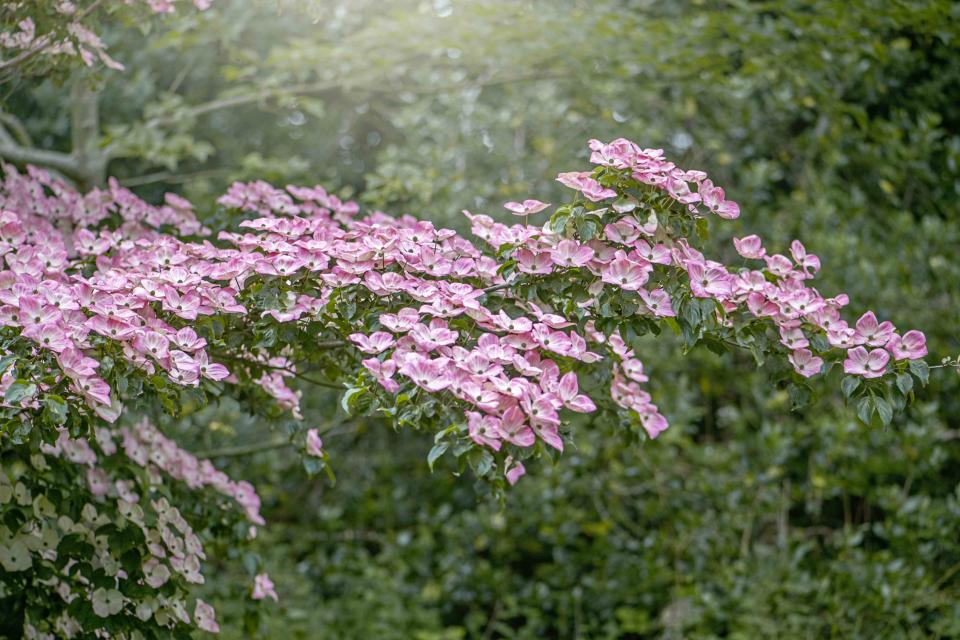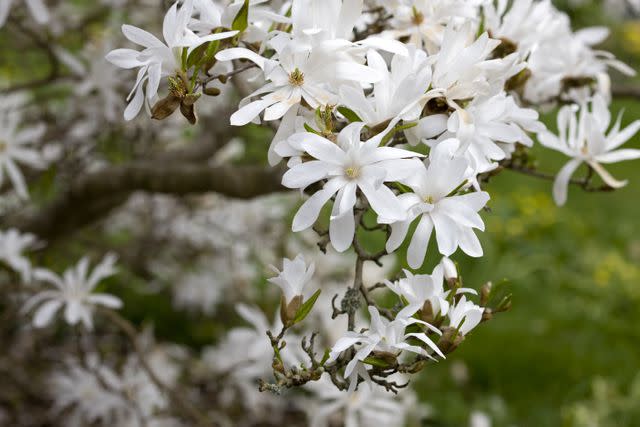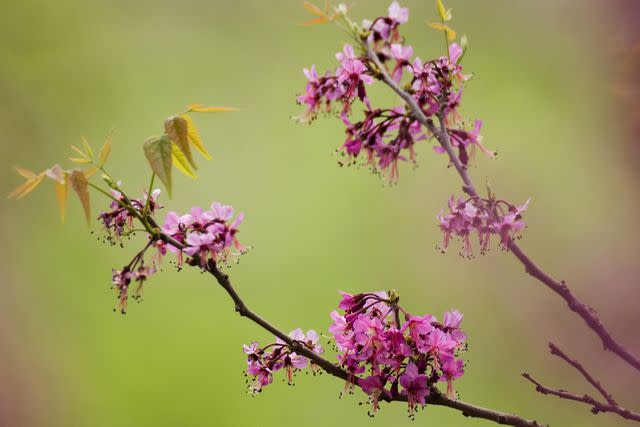6 Flowering Trees That Will Add Beauty and Fragrance to Your Yard
With their other-worldly blossoms and attractive growing habits, these trees will become the jewels of your garden.

Getty Images/Jacky Parker Photography
Flowering trees make for a stunning centerpiece in any yard. They not only signify the arrival of different seasons with colorful, vibrant blooms, but they also lend sweet aromas and a sense of whimsy to your garden. Better yet, they're a boon to the environment, attracting pollinators and serving as a haven to birds, bees, butterflies, and other beneficial insects.
"Flowering trees also play a crucial role in absorbing carbon dioxide from the atmosphere," says Greg Thomas, co-owner of Barton Springs Nursery in Austin, Texas. "While all trees are known to purify the air, recent studies suggest that smaller ornamental trees—such as understory trees—can store carbon dioxide for longer periods than larger trees."
Given all their benefits, adding a few flowering trees to your yard makes perfect sense. Here are some of the most beautiful options to consider if you're ready to enhance your outdoor space.
Related: The Fastest-Growing Trees to Plant in Your Garden
Star Magnolia (Magnolia Stellata)

Getty Images/AYImages
True to its name, the star magnolia is a small, deciduous tree that yields papery, star-shaped blossoms. The blooms perch on bare stems in the early spring—signaling that warmer months are around the corner—and leaves follow close behind. "The green leaves are attractive throughout the warmer months and have pretty crinkled edges," says Breanna Sherlock, in-house plant expert for the Planta App. "These trees are prolific bloomers and are covered in really fragrant flowers."
The star magnolia is somewhat rare, but you're apt to have some luck at a local nursery. They're affordable and make for a beautiful addition to smaller yards and gardens, adds Sherlock.
Care Requirements
Star magnolias are relatively easy to care for, since they're disease resistant and are low maintenance in terms of water consumption. They thrive in well-draining, moist, acidic soil, and prefer partial to full sun. Ideally, the tree should receive between four and six hours of full sun per day, which will encourage blossoms. For the first few years, you'll want to water the tree once weekly during the growing season—but once it is established, you can cut back to about every other week.
Zones: 4 to 9
Mature Size: 15 to 20 feet tall x 15 to 20 feet wide
Care Level: Easy
Click to Discover Your Garden Zone
Yoshino Cherry Tree (Prunus x Yedoensis)

Getty Images
You can enjoy gorgeous cherry blossoms in your own yard—no spring trip necessary. A seasonal stunner, the Yoshino cherry tree produces a profusion of white-pink blossoms on bare branches and has a faint almond fragrance. "This tree, also known as the Japanese flowering cherry, is the main event at many cherry blossom festivals around the world," says Nicole Shah, a gardener and co-founder of Garden Girls. "In summer, you will enjoy the tree's vase-shaped canopy and glossy green leaves."
It's not only an aesthetic beauty: The tree also serves as an important source of food for birds like robins and cardinals.
Care Requirements
The Yoshino flowering cherry tree requires a bit more maintenance up front, but once it's established, it's easy to care for. This tree variety takes to many types of soil conditions, including loamy, moist, sandy, and clay. Opt for a location with full sun and water deeply in the first three to five months to encourage rooting. Once established, water only as needed during extended dry periods. Pruning isn't necessary, but it's helpful to deadhead in late winter or early spring before the next set of blossom's arrive, explains Shah.
Zones: 5 to 8
Mature size: 30 to 40 feet tall x 25 to 40 feet wide
Care: Moderate
Mexican Buckeye (Ungnadia Speciosa)

Getty Images/Wolfgang Kaehler
The Mexican Buckeye is a beautiful deciduous tree with multiple trunks that displays a profusion of aromatic, light pink or mauve-hued flowers. "It blooms from late spring through summer, and during this time, its leaves turn into a captivating deep bronze hue," says Thomas. "The tree's exquisite blooms also serve as a host for a wide variety of butterflies, enhancing the beauty of your garden."
Growing up to 30 feet tall and with a stretching, broad canopy, the Mexican Buckeye is renowned for its smooth light gray bark and dangling leaflets that can reach up to 5 inches in length. Its unique features make it an excellent addition to any landscape, providing both aesthetic and ecological benefits.
Care Requirements
The Mexican Buckeye is moderately easy to care for. It prefers full sun to partial shade in zones 7 through 11, and should receive supplemental water when it's first planted in order to establish the rooting. But like many other plants that thrive in hot and dry conditions, the Mexican Buckeye doesn't like wet feet. Make sure soil drains well; don't overwater once established. This tree is very tolerant of heat and considered hardy. Pruning isn't required, but you can lightly trim it to create your preferred shape.
Zones: 7 to 11
Mature Size: 20 to 30 feet tall x 15 to 20 feet wide
Care Level: Moderate
White Dogwood (Cornus Florida)

Getty Images/Teresa Kopec
No matter the season, the white dogwood is ready to put on a show. "In spring, it produces white flowers," says Shah. The blooms, which are a mainstay from March through May, are actually "bracts" or modified leaves featuring small blooms at the center. These are a thick, creamy white with a golden-green bud; pink spots tend to appear on the tips of each petal.
In summer, the blooms fade, but the leaves take on a gorgeous, glossy green that nearly sparkles in the sunlight. "The tree shows off again in fall when the foliage turns a vibrant red-purple, and the red fruit attracts winter songbirds," says Shah.
Care Requirements
Dogwoods thrive in partially shaded areas where larger trees help provide a canopy of protection from direct sunlight. Because they adapt well to many soil conditions and require no pruning, white dogwoods are considered a low-maintenance flowering tree. They tend to get enough water from rainfall, but if you're experiencing a dry spell, give them a good drink once per week.
Zones: 5 to 9
Mature Size: 15 to 30 feet tall x 15 to 30 feet wide
Care Level: Easy
Bottlebrush (Callistemon Rigidus)

Getty Images/ClaireLucia
Also referred to as Callistemon trees, bottlebrush trees are characterized by their peculiar and fuzzy bright red flower spikes that resemble, well, a bottlebrush! Thomas says that this eye-catching tree is one of his absolute favorites since it feels uniquely different from other flowering trees and plants. "The leaves of Callistemon rigidus are narrow, lance-shaped, and grow up to 4 inches long. They have a leathery texture and are dark green in color, providing a beautiful contrast to the tree's showy flowers," Thomas says. "The bottlebrush-like flower spikes of Callistemon rigidus are about 3 to 4 inches long, and bloom in shades of pink to red."
The bottlebrush is a smaller tree that grows to about 10 to 25 feet in height and remains compact at around 10 feet wide. The Callistemon rigidus, in particular, is a species of bottlebrush that features a dense, upright growth habit, which makes it a particularly striking pick for a garden.
Care Requirements
With proper care and maintenance, bottlebrush trees can thrive in a variety of climates, providing a stunning display—even in colder regions. They prefer full sun, but can tolerate partial shade; when choosing a location, opt for an area that receives at least six hours of direct sunlight per day. Bottlebrush trees prefer moist, well-drained soil and Thomas recommends watering the tree deeply once weekly, especially during hot and dry weather conditions. Avoid overwatering, which can lead to root rot.
Zones: 9 to 10
Mature Size: 10 to 25 feet tall x 10 feet wide
Care Level: Easy
Flowering Crabapple (Malus 'Royalty')

Getty Images/Cheunghyo
For a real garden showstopper, look no further than the gorgeous flowering crabapple. The Royalty variety produces purple-meets-crimson flowers, which are striking all on their own. The addition of a deep, dark foliage adds more richness of color. Sherlock says that the flowers and fruits produced by the tree are very attractive to bees and wildlife. Their size makes them a great focal point of any garden, though they're a particularly great pick for smaller yards.
The seeds of these trees are quite easily located—inside the fruits they produce, of course—but note that they can take about three to five years to produce flowers. It's well worth the wait if you have the patience.
Care Requirements
Crabapple trees are a garden staple for a reason—they're easy to care for and the reward you with their fragrant blossoms. "They can grow in all kinds of conditions, but will thrive in humus-rich soil," says Sherlock. "You don't need to undertake any hard pruning, but removing suckers—the shoots at the base—is good practice so that the plant's energy isn't wasted." These trees love full sun and well-draining soil.
Zones: 4 to 8
Mature Size: 15 to 20 feet tall x 15 to 20 feet wide
Care Level: Easy

